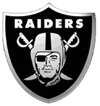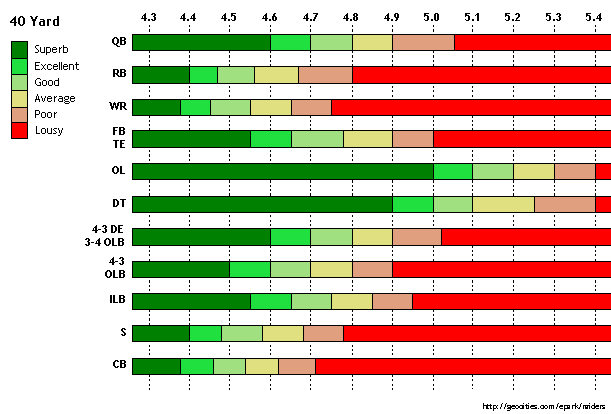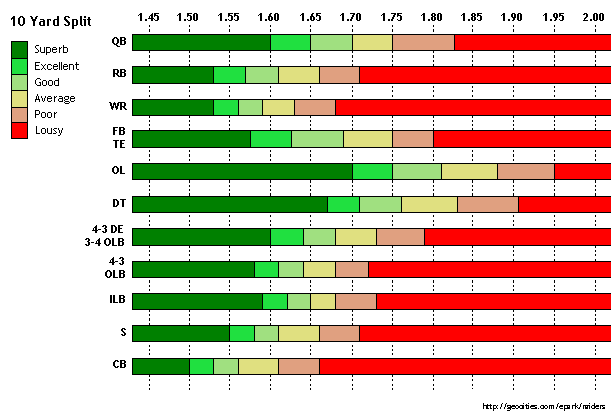
Edweirdo's Oakland Raiders Report |
How can you tell how good a football player is? Watch him play! Does the player have good instincts, technique, desire, athletic ability, and football intelligence? Does he make big plays? The problem with just watching film is that there are so many variables, including:
That's why I love the all-star games, such as the Senior Bowl. You get to watch quality players compete against one another, in practice and in the game. However, not all draft-eligible players participate in the all-star games.
Therefore, every year in late February, the NFL invites hundreds of draft-eligible players to the Combine in Indianapolis, where teams can check out the draft talent up-close. NFL teams value the NFL Combine for many reasons:
Combine measurables consist of physical tests (40-yard dash, bench reps, short shuttle, 3-cone, vertical jump, broad jump), the Wonderlic, and size measurements (e.g. height, weight, hand size, arm length, etc). Are the physical tests important? Sure, in the right context: they are an indicator of athletic ability. But they don't necessarily reflect a player's football ability. People (the media, teams, and fans, including me) tend to get carried away with the fastest 40-yard dash times. Here are the measurables I pay attention to and why:
For more information on the Combine tests, check out the writeup by The Red Zone.
After looking at recent previous drafts, I put together some charts that breakdown numbers into the following categories:
One thing to note is that numbers have been improving year-to-year. This shouldn't be surprising, given the increasing popularity of professional trainers, who help players maximize their measurable performance. E.g. there were an incredible number of CBs and WRs who ran under 4.4 in the 40 at the 2005 Combine, and that is an insanely fast time.


In a terrific article, Pat Kirwan provides a simple formula for assessing a player's short shuttle time:
A general rule of thumb that I used in comparing the 40-yard dash times (speed) to the 20-yard short shuttle (quickness) was to subtract .5 seconds from the 40 time to arrive at the right short-shuttle time. For example, if a player ran 5.0 in the 40-yard test, I would expect to see 4.5 in his short shuttle to measure his quickness as it relates to his speed. If a player ran 5.0 in the 40 and had a 4.3 short shuttle, then he was .7 better and I knew he was more quick than fast. If a player ran a 4.5 in the 40 and also ran a 4.5 short shuttle, I realized I was looking at a player with straight-line speed, or as we like to refer to them "track speed" guys.
One thing to keep in mind for these tests is the size of the player. Smaller players should have an advantage over their bigger counterparts. It says a lot about a player's athletic ability when he is big but does well in these tests. E.g. Raiders' OT Robert Gallery put up ridiculous shuttle (4.38) and 3-cone (7.43) times considering he was 6-7 323.

For some players, the Combine validates the football skills and athletic ability that made them successful. Take RB Darren Sproles, for example. He showed top-notch burst and agility in the RB drills, and he graded out very high in almost every measurable test. Teams still have doubts about Sproles' size, but the guy has shown he has the talent. On the other hand, you have guys like Maurice Clarett, who proved (for the 2nd straight Combine) that he lacks the maturity to merit getting drafted. If you haven't heard, Clarett bagged the rest of the tests and RB drills after clocking an embarrassing 4.8 and 4.7 in the 40. The Combine also exposes players who have weaknesses in their game. E.g. Southern Illinois' RB Brandon Jacobs showed good straight-line speed (4.56 40) at his size (6-4 267) but struggled noticably in the RB agility drills and quickness tests (4.5 shuttle, 7.5 3-cone). Jacobs had a stellar performance at the Shrine Game, but what I realize in retrospect is that he never made more than 1 significant cut on any of his runs. He probably can not make multiple cuts without slowing down, as the measurables suggest.
All that said, Combine numbers should be taken with a grain of salt. At the end of the day, I'd rather have a great football player and good athlete (e.g. 4-3 DE / 3-4 OLB Terrell Suggs) than a good football player and great athlete. After a stellar career, including a senior season in which he set the NCAA record for sacks, Suggs was widely regarded as a top 5 or 6 pick in the 2003 Draft. However, Suggs ran a pedestrian 4.8 in the 40, and doubts surfaced about his speed off the edge at the next level. He fell to the Ravens at #10 overall and proved doubters wrong by earning defensive rookie of the year honors. David Pollack is the 2005 Draft's Terrell Suggs: a phenomenal football player who lacks some prototypical measurables. Pollack should be a top 10 pick based on what he showed on the field (and in the Combine DE drills and quickness tests: 3.9 shuttle, 6.9 3-cone). But he may fall to the teens because of his height (6-2), short arms, and 4.8 40 time. You can't coach athletic ability, but then again, you can't always teach the kind of football skills and instincts that players such as Suggs and Pollack possess.
If you have feedback / comments for this article, email me at edweirdosraiders@gmail.com. I may add them to this page.